10年近く前に、「レコードにおける『EP』とは、いつ生まれた用語なのか、元々どういう意味で使われていたのか」について調べた記事を掲載しました。いろんな方に読んでいただき、また多くの方に追加情報を寄せていただきました。
今回は、その2012年の記事の後に、知った/見つけた/分かった、追加情報について、後日談としていくつか紹介してみることにします。
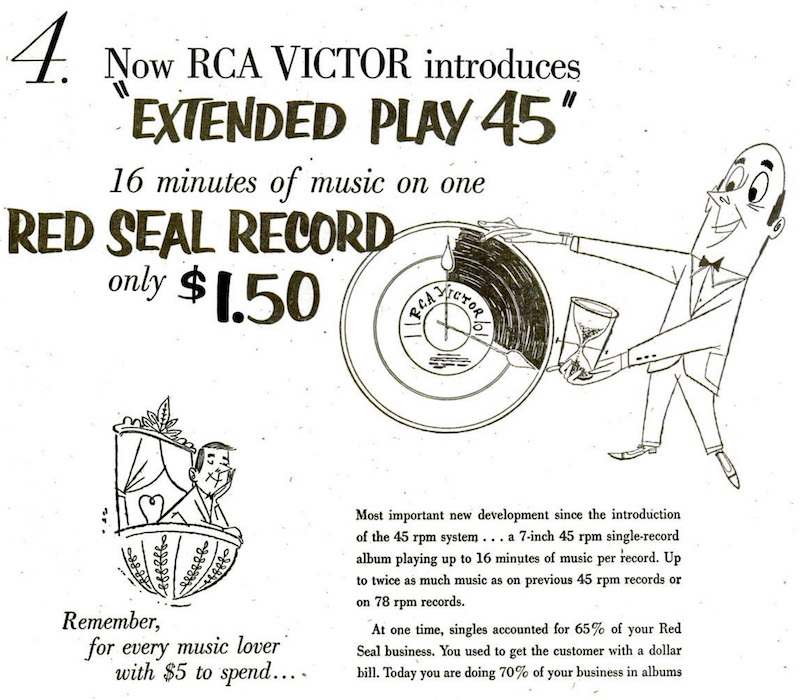
source: “How to play records for money”, The Billboard, Vol.64, No.43, October 25, 1952, p.44
Contents / 目次
日本における「EP」という用語の受容史
2022年12月21日、国立国会図書館デジタルコレクション がリニューアルし、全文検索可能なデジタル化資料が一気に充実したニュースがかけめぐりました。
そんな折、Twitter 上で tuesdaybreakheart さん が、日本における EP の歴史、コンパクト盤(33 1/3回転 7インチ盤)の歴史の探究を始められていました。
先日の日本のレコード会社のEP→コンパクト盤に一斉切替の件、話題の国会図書館デジタルコレクションで見てみようと軽い気持ちで覗いてみたら、著名レコードショップの味わいのありまくる広告などが面白くてなかなか本題にたどり着きませんで…。https://t.co/hfmK97PbII pic.twitter.com/KGiF0RrAci
— tuesdaybreakheart (@tuesdaybreakhea) December 24, 2022
そして2023年3月21日、「EPとはなんだったのか — 日本の45回転レコード創成期とコンパクト盤(上)」という記事を公開されました。必読です。
読み応え満点の内容で、ぐいぐいと引き込まれます。また、米国に比べてディジタルアーカイブの意識がどうしても低い日本ですから、過去の状況を調査しようにも手間がかかり大変だったのですが、国立国会図書館デジタルコレクションのリニューアルによって、数多くの書籍や雑誌、資料、広告等に(その気になれば)検索しアクセスできるようになった、そんな喜ばしい変化を代表する記事と言えます。
続編(下)も期待しています。
2023/06/24 追記:
そしてついに後編(下)が公開されました。米国におけるステレオ7インチ盤をめぐる攻防の話、日本の状況、その他の国(特に南米)の状況など、時系列で非常に整理されており、こちらも必見です!
「LP」は登録商標だった(のちに一般名詞化)
1952年、RCA Victor が発表した EP (Extended Play) に関連して、1948年、Columbia が発表した LP (Long Playing) について。
先日掲載した LP 誕生のエピソード記事中、セクション11.2.11 で触れましたが、LP の技術自体は特許になっていませんでした。ですので、どのレーベルも(ライバルの RCA Victor ですら)特許料などを支払うことなく、独自に長時間マイクログルーヴ盤を製造販売することができました。
唯一、Columbia がパテント、正確には登録商標をとっていたのが、「LP」という用語そのものです。
1948年6月、LPお披露目当時の Columbia 社長である Edward Wallerstein 氏が、1967年11月にインタビューを受けた際、次のように語っている箇所があります。
I was glad it went the way it did. Actually I think that Paley was badly advised on the possibility of a licensing arrangement, which was the only reason he showed it to RCA.
(CBS会長の William Paley が、1948年4月、LP発表の2ヶ月前に、RCA 社長 David Sarnoff に、Columbia Long Playing Microgroove レコードに関するライセンス契約を持ちかけたが、結局話は流れた、という件に関して)、そうなって良かった、と私は喜んだものだ。実際のところ、Paley は、ライセンス契約の可能性について、良くないアドバイスを受けていたのであろう。それがなければ、そもそも(極秘開発したLPを発表前に)RCA に見せるなんてことはしないはずだから。
The only protection that Columbia had for its new development was the term “LP” itself, which I had originated and which we had then copyrighted. As a consequence, although many other firms could make long-playing records, only Columbia could make an LP. However, because of its constant usage, the term has since passed into the vocabulary along with nylon and aspirin.
Columbia が一連の新開発に関して唯一保護できたものは、「LP」という用語そのものだけだった。これは私が発案したもので、登録商標化した。結果として、どの会社も長時間レコードの製造は行えたが、「LP」を作ることが可能だったのは Columbia のみだった。しかし、常に使われ続けた用語であったため、結局(一般名詞化して)「ナイロン」や「アスピリン」と同じ道をたどることとなった。
“Creating the LP Record: How the long-playing disc was piloted through lab and board room to the public”, Edward Wallerstein as told to Ward Botsford, High Fidelity, April 1976, Vol.26, No.4, pp.56-61Wallerstein 氏は「LP という用語を思いついたのは自分だ」と言っていますが、一方 Peter Goldmark も自叙伝の中で「自分がLPという用語を思いついた」と言っています。相変わらず2人の仲の悪さがうかがえるエピソードではあります(笑)
Earlier, Stanton thought we needed a name and ordered a companywide contest. Twenty-five names were considered, but all were rejected. “I guess the LP isn’t going to have a name after all,” I said.
(CBS社長の) Stanton 氏が、(長時間再生レコード = Long Playing という新開発には)名前が必要だ、と考え、社内コンテストを開催した。25種類の名前があがり、熟考の末、全てリジェクトされた。そして私は口にした。「どうやら LP には名前がつきそうにありませんね」と。
Startled, Stanton said, “What did you say?” I repeated my statement, and that’s how LP got its name.
Stanton 氏は驚いたように「いま何て言った?」と口にした。私は先ほどの言葉を繰り返した。こうやって「LP」という名前がついたのだった。
“Chapter 8: The LP Caper, or the Case of the Missing Fuzz”, “Maverick Inventor: My Turbulent Years at CBS”, Peter C. Goldmark with Lee Edison, Saturday Review Press, 1973, p.143確かに、マイクログルーヴLP黎明期のジャケットを見ると、Columbia のものには「LP」と書かれていますが、それ以外のレーベルでは「Long Playing」と書かれています。いつ一般名詞化したのかは分かりませんが、ともあれ最初期は「Columbia のみが LP というタームを独占利用可能だった」ようです。
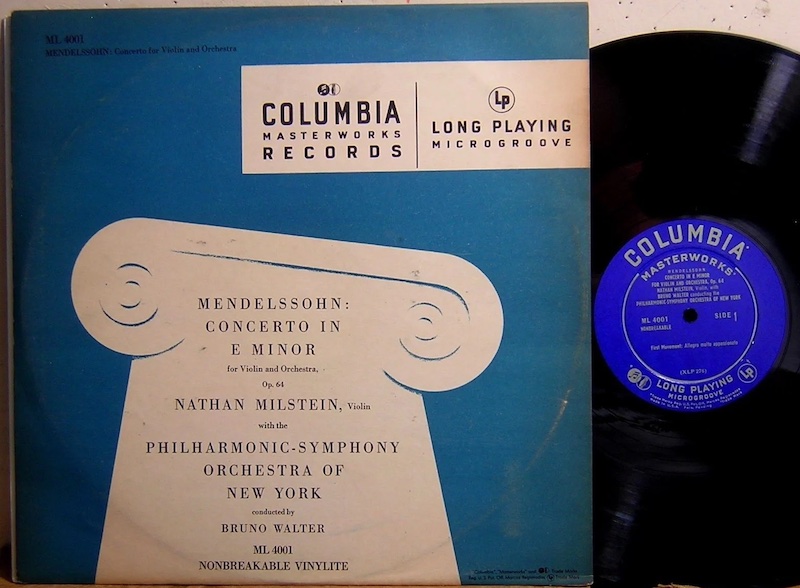
from: POPSIKE.COM
市販された世界初のマイクログルーヴLP、Columbia ML-4001 (1948年6月)
ジャケにもレーベルにも「Lp」表記が見えます
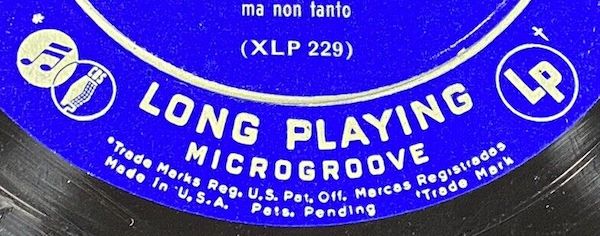
Columbia ML-4006 のレーベル下部
(Lp) が Trade Mark である旨書かれている
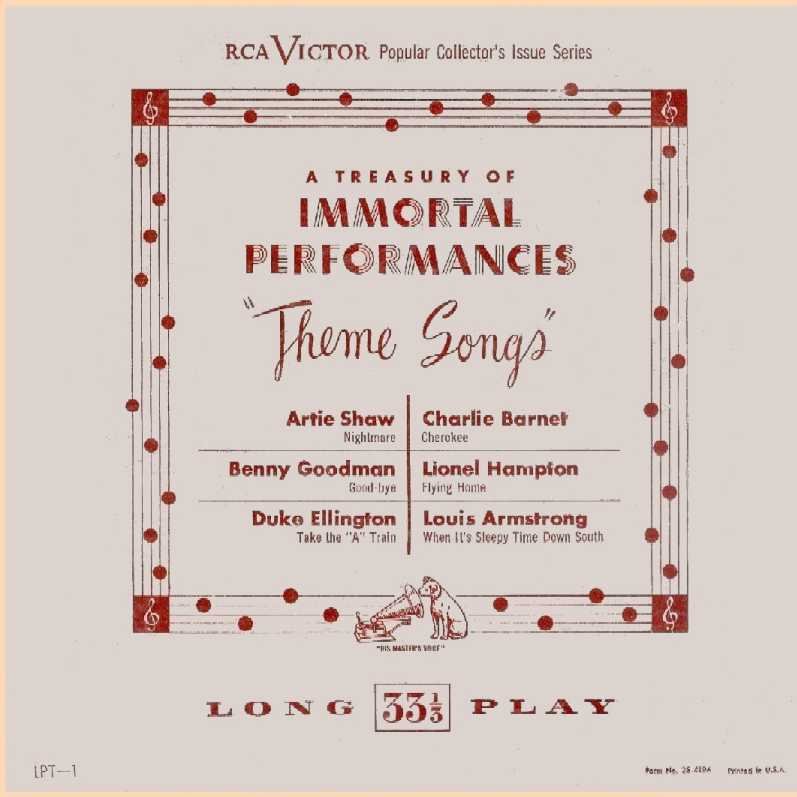
from: 45worlds.com
1951年にRCA Victorが最初に出した33 1/3回転LP(10インチ盤)
「LONG PLAY」とは書かれているが、「LP」とは書かれていない
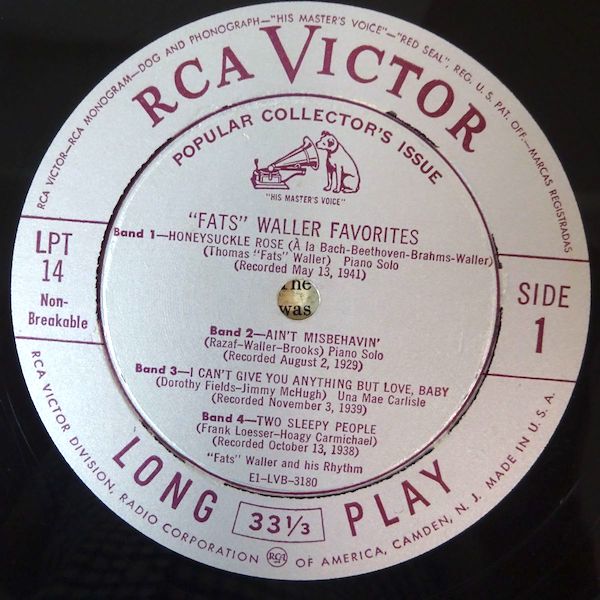
from: aucfan
RCA Victor LPT-14 (1953) のレーベル
確かに「LONG PLAY」とはあるが「LP」とは書かれていない
で、あくまで妄想レベルの仮説なのですが、Columbia の「LP」に負けないくらい、RCA Victor も LP に匹敵するくらいシンプルなネーミングを用意して、新開発レコードに名付けたい、というライバル心から「EP (Extended Play)」という呼称をひねり出したのかもしれませんね。
Billboard 誌 1952年10月25日に掲載された RCA VICTOR の特集記事
最も有名なレコード業界誌の1つ、The Billboard 誌に EP (Extended Play) という用語が初登場したのは、前回の拙記事 の通り、1952年8月9日号21ページの記事「Victor to Distribute Extended Play 45’s」でした。
その後、RCA Victor による EP 一大キャンペーンが始まるのですが、同じく The Billboard 誌 1952年10月25日号の誌面上で一大キャンペーンの特集記事が掲載されています。その名も「EVOLUTION AND EXPANSION: A Review of the RCA Victor Fall-Winter, 1952 Program」です。
記事と広告は27ページ〜54ページに渡り、RCA Victor が発表した1952年秋冬の販促プログラムを分析するものです。このような、特定のレーベル/企業のプログラムを誌面の長編記事で解説するのは、Billboard 誌の57年の歴史上初めての実験的な試みである、と、当時の編集長 Joe Csida 氏の巻頭言も掲載されています。Csida 氏はのちに Capitol や RCA Victor に移籍、A&R などを務めた人物です。
その4ページに渡る特集記事の中から、特に EP に関する記事「Extended Play – the Evolutionary Heart of RCA’s New Disk Program」から一部をみてみましょう。じゃっかん提灯記事の気配も感じますが(笑)、デビュー直後の「EP」が、当時のレコード業界でどのように捉えられていたか(または RCA Victor が EP 導入でどのように市場の巻き返しをはかろうとしていたか)を読み解く資料としては有用と感じました。
Extended Play – the Evolutionary Heart of RCA’s New Disk Program
Extended Play: RCA の最新レコードキャンペーンの発展における心臓部
Extended Play, or EP records, as RCA Victor is working to popularize them, actually represent the heart of the company’s 1952 fall program. EP’s are actually an extension of the record industry evolution, which started with the introduction of the new speeds in ’48-’49. They are, furthermore, RCA’s all-out attempt to regain a vast portion of the record market, which may have been priced out of the picture in recent years, and lost sight of to a considerable degree during the hectic days of the introduction of the new speed records, and the years which followed.
Extended Play (EP) レコードは、RCA Victor 社が普及に努めているものだが、実はこれこそが同社の1952年秋のプログラム(キャンペーン)の中核をなすものである。この EP レコードは、1948年〜1949年にかけて起こった、新しい回転数(33 1/3回転と45回転)の導入に始まる、レコード産業の進化の延長線上にあるものである。さらに言うなれば、新回転数導入直後の混乱およびその後の数年間において値崩れしてしまい見失ってしまった、レコード市場の大部分を、RCA が全力で取り戻そうとする試みでもある。
For example, RCA’s own statistics show that prior to the introduction of the new speed records about 65 per cent of all Red Seal (RCA Victor classical) record business was done on single records. Since the introduction of the new speeds about 65 per cent of the business has been done in albums, and LP records. This led the company to the conclusion that a tremendous amount of volume was possibly being missed by record dealers, volume represented by the classical record buyer who could afford to spend $1.50 per record for the specific selection he desired, but either could not afford, or didn’t care to spend two and three times the amount for more extensive works, only a portion of which he really wished to own.
例えば、RCA社内の統計によれば、新しい回転数のレコードが導入される前は、Red Seal (RCA Victor のクラシック) のレコードビジネスのうち、約65パーセントがシングルレコードによるものだった。一方、(1948年の 33 1/3回転 LP、1949年の 45回転シングルなど)新しい回転数のレコード導入後は、ビジネスの約65パーセントはアルバムやLPレコードによるものとなっている。この結果から、同社は次のような結論を出した。クラシックレコードを買う人は、自分の好きなレコードを1枚1.5ドルで買うことはできても、その2倍も3倍もするような大作を買う余裕はないか、または買う気になっておらず、本当に所有したいのは(アルバムやLPに収録された)一部分であり、そういった購買層による販売枚数が大幅に減少しているのだ、と。
The solution developed was the EP classical record. For an EP record, as most tradesters know, is simply a standard-sized, 7-inch, 45 r.p.m. disk, on each side of which up to eight minutes of music may be played. Thus on two sides of RCA Victor EP record, WEPR-32, the buyer finds Debussy’s “Clair de Lune,” Liszt’s “Liebestraum, No. 3,” and the “Polonaise in A-Flat, Opus.53, No.6” by Chopin, all performed by Jose Iturbi. Sixteen minutes of pre-selected, sales-proven Iturbi classical hits.
これを解決するために(RCA Victor によって)開発されたのが、クラシック音楽用の EP レコードである。業界関係者はご存知の通り、EP レコードとはシンプルな標準的サイズの7インチで、45回転の盤である。EP レコードの両面にそれぞれ最大8分間の音楽が収録可能である。よって、購買者は RCA Victor の EP レコード WEPR-32 の両面に、ドビュッシーの「月の光」、リストの「愛の夢 第3番」、ショパンの「英雄ポロネーズ (ポロネーズ第6番 変イ長調 Op.53)」、これら全てが収録されているのを目にすることとなる。しかも全てホセ・イトゥルビの演奏である。売れること間違いなし、イトゥルビによる選りすぐりの16分間の演奏が1枚のEPに収録されているのである。
Extended Play - the Evolutionary Heart of RCA's New Disk Programこのように、Columbia との熾烈なライバル競争を行っていた RCA Victor にとって、なんとしても自社の独自技術(45回転)で、Columbia の LP(33 1/3回転)を圧倒したい、RCA Victor が引き続きレコード業界をリードしたい、という思惑が透けてみえるようです。
続いて、1952年9月10日〜10月10日の1ヶ月間に RCA Victor がリリースした EP クラシックシリーズは、すでに 45万枚以上売れていることに触れ、さらにはポピュラーシリーズ、そして2枚組EPについても同様の言説が続きます。
The popular EP single record and two-record packages, of course, are designed to solve yet another current marketing problem. Here there is no question of the single record sale. The 89-cent (retail) popular 45 r.p.m. record, with a single selection on each side, has steadily increased in sales and popularity. Here the question was simply whether a great many more persons, particularly younger people with limited allowances and budgets for such luxury items as records, wouldn’t be inclined to buy popular albums, if such albums were lower-priced. EP offers an ideal opportunity ot test this theory. With two selection on each side of a single record, the customer, of course, gets the equivalent of a two record album, when he purchases the single-record popular EP 45. And he gets it for $1.40, a considerable saving over what he was required to pay for the standard 45 r.p.m. two record album.
もちろん、ポピュラー音楽の EP レコード、および 2枚組 EP レコードパッケージも、別のマーケティングの問題を解決すべく設定されている。現時点では、シングル盤(45回転)の売れ行きにはなんの問題もない。片面1曲ずつ収録された、89セント(小売価格)のシングル盤は、着実に売り上げと人気を伸ばしている。ここで、レコードのような嗜好品の購入に割ける予算が限られている若者をターゲットとして、ポピュラー音楽のアルバムがもっと低価格で提供できたならば、より多くの若者が買おうとするのではないか、との仮説があげられる。つまり EP は、この仮説を検証する絶好の機会となるのである。1枚の45回転EP盤には、両面に2曲ずつ収録されており、2枚のシングル盤で構成されたアルバムを買うのと同等となる。しかもEP版の価格は1ドル40セントであり、通常の45回転シングル盤の2枚組アルバムよりかなりお得に購入可能である。
Similarly, for $2.80 in the two-record popular EP package, the young customer gets eight selections, or the equivalent of the four-record, standard 45 r.p.m. album. And again at a tremendous saving.
同様に、2枚組 EP パッケージは $2.80 であり、若い購買層はこの価格で8曲を手にすることになる。これは通常の 45回転シングル盤の4枚組アルバムと同等であり、これもまたかなりお得な価格となっている。
Extended Play - the Evolutionary Heart of RCA's New Disk Program1952年当時、すでに LP (10インチおよび12インチ) が米国のほぼ全レーベルからリリースされている状況で、専用のオートチェンジャーを必要とせず長時間再生可能であるメリットが浸透していましたが、ポピュラー音楽の世界では、シングル盤の需要も非常に根強くありました(いや、むしろ、ポピュラー音楽では、楽曲単位で購入可能なシングル盤の方が、購買層の需要とよりマッチしていたのでしょう)。
しかし、RCA Victor は、「LP を買うまではいかないが、シングル盤以上のメディアを欲している、そんな購買層がかなりいるはずだ」という信念のもと、EP という新メディアを開発し、精力的にキャンペーンを行なった、そんな思惑が窺えるように思います。結果として、歴史が証明する通り、EP 自体は LP を置換することはなく、米国では EP のリリースは1950年代末にはほとんどなくなり、以後はシングル盤とLPが共存する時代が訪れることとなるわけですが。
さらに同誌では、31ページから52ページまでに渡り、カートゥーン入りの長編広告「How to play records for money」(お金になるレコードのかけ方)が掲載されています。主にレコードディーラに対し、RCA Victor のレコードで、いかに売り上げを伸ばすか、のヒントにしてもらうべく、1952年秋冬の一大キャンペーンの解説が行われています。
31ページの左下には「どうぞ楽になさってください。(この広告は)22ページも続きます」と書かれているのが面白いです。
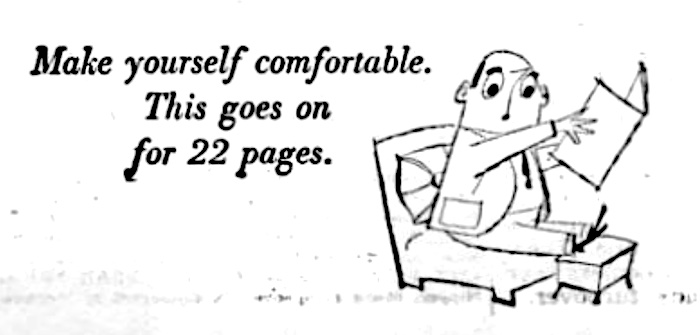
source: “How to Play records for money”, The Billboard, Vol.64, No.43, October 25, 1952, p.31
この広告記事の44ページ〜47ページで、Extended Play (EP) の紹介が行われていますので、ぜひご覧になってください。以下、EP の(ディーラ向け)広告ページに添えられたキャプションです。まずは、クラシック音楽用のシリーズである Red Seal の EP 盤から。
Most important new development since the introduction of the 45 rpm system . . . a 7-inch 45 rpm single-record album playing up to 16 minutes of music per record. Up to twice as much music as on previous 45 rpm records or on 78 rpm records.
45回転盤システム登場以来の最も重要な新開発 . . . 7インチ、45回転、レコードアルバムで、1枚につき最大16分間の音楽を再生可能。従来の45回転盤(シングル盤)および78回転盤に比べ最大2倍の音楽を収録。
At one time, singles accounted for 65% of your Red Seal business. You used to get the customer with a dollar bill. Today you are doing 70% of your business in albums … getting only customers with a five dollar bill. A big part of your Red Seal market has become virtually inactive.
かつて、Red Seal (RCA Victor クラシック) の売り上げの65%をシングル盤(78回転盤)が占めていましたよね。昔は顧客1人につき1ドル札を獲得していたんですよね。さて今日、あなたはビジネスの70%をアルバムで行っています。つまり5ドル札を持つ顧客しか獲得できていないのです。Red Seal の市場の大部分は、事実上機能していないのです。
Now, “Extended Play” recovers that mass market for you . . . brings back the customer for Red Seal singles with a better value and a better profit at a retail price of only $1.50. With a compact, attractive package, “Extended Play” makes possible – for the first time in history – effective display and merchandising of Red Seal singles, by creating an appealing single-record album on “45.”
そこで「EP」が、(ディーラの)皆さんのために、マス市場を取り戻します . . . 小売価格わずか1.5ドルで、より良い価値と利益をもたらす Red Seal シングル盤の顧客を取り戻すのです。「45回転」のレコード1枚からなるアルバムを作ったことにより、コンパクトで魅力的なパッケージの「EP」は、史上初めて、Red Seal シングル盤の効果的なディスプレイとマーケティング戦略を可能にしました。
For the first time, great sellers which play over five minutes and less than eight are now on a single side at low cost; “March Slav,” “Finlandia,” “Hungarian Rhapsody #6,” opera overtures, Strauss waltzes, and many others.
例えば「スラヴ行進曲(チャイコフスキー)」、「フィンランディア(シベリウス)」、「ハンガリー狂詩曲第6番(リスト)」、オペラの序曲、シュトラウスのワルツ、その他多数の、5分以上8分以下のベストセラー楽曲が、レコード片面に収録されるのです。
Compare the present price of $2.62 for the same music on 78 rpm, without a package! Compare the same musical selection now offered on competitive 33 1/3 rpm for $2.85 without the advantage of the great RCA Victor artists!
同じ音源の78回転盤が、パッケージなしで、現在 2.62ドルなのと比べてください! 同じ楽曲が収録された、ライバルの 33 1/3回転盤は、偉大なる RCA Victor 契約アーティストでないのに 2.85ドルもするのと比べてください!
With arias by great Metropolitan Opera artists figuring at 38¢ an aria . . . with a complete Rossini overture played by Toscanini figuring at only 75¢, you can now harness the great RCA Victor names to your enourmous potential mass market. More music for less money for the customer with a dollar.
メトロポリタンオペラの偉大なアーティストによるアリアは1曲わずか38セント。トスカニーニが演奏するロッシーニ序曲の完全版 ががわずか75セント。たったこれだけのコストで、RCA Victor の偉大なるアーティスト達を、膨大な潜在的大衆市場に利用することができます。「1ドル紙幣を持つ」顧客にとっては、より少ない出費でより多くの音楽を楽しむことができるのです。
“Now RCA VICTOR introduces EXTENDED PLAY 45 - 16 minutes of music on one RED SEAL RECORD”, The Billboard, October 25, 1952, pp.44-45。。。マーケティングとしてはなんか弱いですよね。45回転シングル盤登場時に、専用オートチェンジャーを使って「長時間再生可能」と喧伝していた時と同様、かなり無理がある宣伝文句のような気がしますが。。。(笑) それだけ、RCA Victor は Columbia の猛追に焦りを抱いていたということでしょうね。
続いて、ポピュラー音楽向けの EP 盤についての広告です。
Just what the game needs: top merchandise and low price. You couldn’t hold a better combination!
(販売競争)ゲームに必要なもの:優れたマーケティング戦略と低価格。これ以上の組み合わせはありえません!
With the new popular albums on “Extended Play 45” comes the biggest boost ever given to the biggest part of your business – the pop market. The new albums give your customers the greatest value ever offered in the record industry – in a handy new form at a dandy new price. Customers who’ve bought only pop singles will now find they save money when they buy albums. A powerful new incentive to convert pop listening 100% to 45rpm, to simplify and strengthen your pop merchandising.
ポピュラー音楽のアルバムの新しい「Extended Play 45」が、最も大きいポピュラー市場においてこれまで以上に皆さんのビジネスを後押しします。この新しいアルバムは、便利な新形状、ダンディな新価格で、レコード業界における今までにない最大の価値を顧客に提供します。これまでシングル盤しか買ってこなかった顧客が、アルバムを買うことで節約できると気づく。ポピュラー音楽のリスナーが全て100%、45回転盤で聞こうとする、強力なインセンティブとなり、ポップス部門のマーケティング戦略をよりシンプルに、より強固なものにできます。
New 2-record albums
新しい2枚組アルバム
The standard pop album in a completely new form. On each side, two full-length selections playing up to 8 minutes. Eight full selections on 2 records, attractively packaged with a liner and full-color album cover. All for $2.80 compared with the former price of $3.75, saving the customer almost a dollar. A brand-new top selection of albums for the kick-off, featuring Fisher, Hutton, Flanagan, Monroe, and others.
ポップスのアルバムが全く新しい形状になります。片面ごとに2曲を収録、最大8分再生可能です。(EP)レコード2枚で8曲が収録されることになり、ライナーノーツとフルカラーのアルバムカバー付き、という魅力的なパッケージングです。従来の(45回転シングル盤のアルバムの)$3.75 と比べ、$2.80 という価格により、顧客はほぼ $1 の節約ができます。EPのキックオフ時には、(Eddie) Fisher, (Betty) Hutton, (Ralph) Flanagan, (Vaugn) Monroe といった極上のセレクションがアルバムリリースされます。
New 1-record albums reduce the price of top pop albums by top stars to the unbelievably low cost of $1.40. 4 tunes packaged with liner and full-color cover in the most attractive “buy” ever made available to the pop fan with a dollar. The pick of RCA Victor’s present 6-tune albums will be modified for this new format. Appetizing new releases are scheduled, leading off with 100 great hits to start the series. A completely new product at a completely new price that’s sure to set tremendous new buying pattern for continuing extra sales.
新しい1枚ものアルバムは、トップスターによるポップスのトップアルバムを、$1.40 という信じがたい低コストにまで引き下げます。ライナーノーツとフルカラーのアルバムカバーと共に、4曲がパッケージングされ、「1ドル紙幣を持つ」ポップスファンの顧客にとっては、最も魅力的な「買い」の商品となります。RCA Victor の現在の(78回転盤、および45回転シングル盤の)6曲入りアルバムは、この新しいフォーマット用に変更が咥えられる予定です。このシリーズ開始にあわせて、まず100にも及ぶヒット曲からなる、魅力的な新譜が予定されています。全く新しい商品が、全く新しい価格で、あ全く新しい購買パターンを確立し、継続的な売り上げ増を実現することでしょう。
...ALSO, FROM NOW ON, ALL RCA VICTOR POP ALBUMS ON EXTENDED PLAY 45!”, The Billboard, October 25, 1952, pp.46-47。。。この数年後には、マイナーなフォーマットになることが確定してしまった EP は、当初、鼻息荒い RCA Victor のマーケティング戦略によって、このように売り出されていたんですね。「歴史から学ぶ」「過去から学ぶ」ことは、本当に多いものだなぁ、と改めて感じます。



